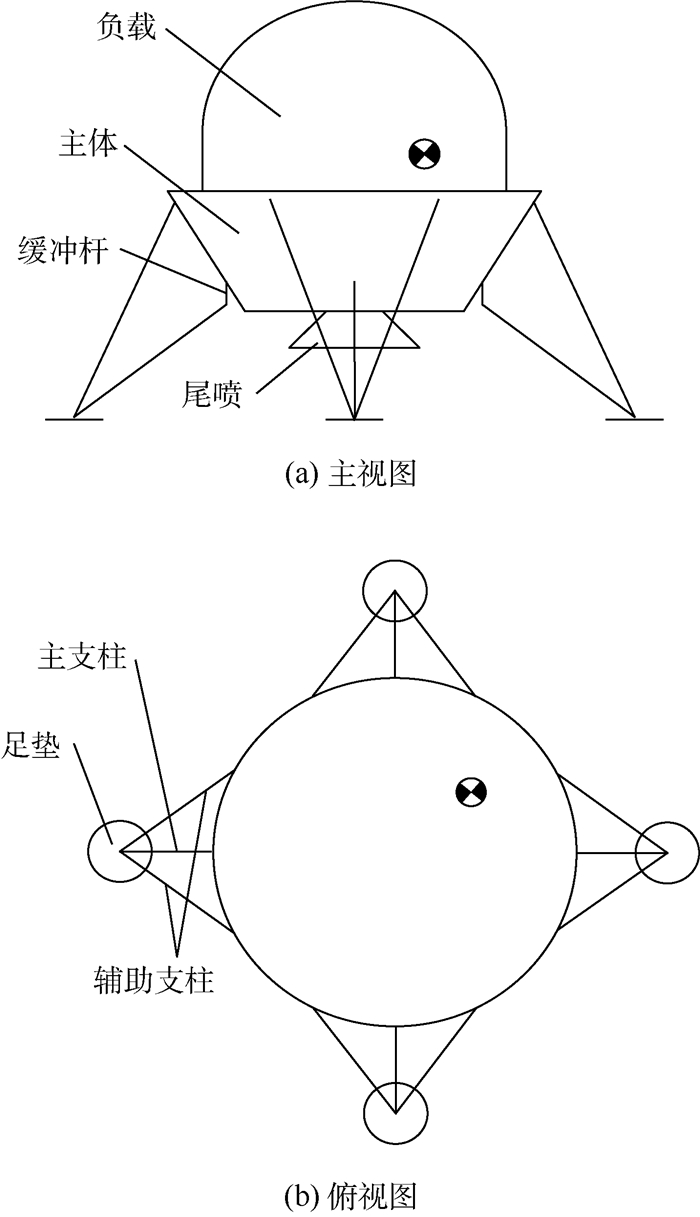Stability analysis of explorer in soft landing mode of engine shutdown at touchdown
-
摘要:
深空探测器软着陆过程中发动机未能正常关闭将极大降低其软着陆稳定性,因此引入了触地关机着陆方案。针对触地关机方案,建立了腿式探测器动力学分析模型及发动机推力控制模型。考虑着陆环境与探测器着陆状态的不确定性,采用蒙特卡罗模拟分别对探测器在主发动机关闭失败时、触地关机着陆方案下、带有姿态控制的触地关机着陆模式下的软着陆稳定性进行了分析。采用描述性采样方法抽取样本点,基于均值估计相对误差建立模拟终止准则,在保证模拟精度的前提下提高蒙特卡罗模拟效率。计算并对比了3种着陆方式下探测器软着陆可靠度,触地关机方案可在主发动机关闭失败后将探测器稳定着陆可靠度提升11.6%,姿态控制的引入可进一步将安全着陆的可靠度提升9.7%。
Abstract:The soft landing stability will be greatly reduced if the main engine of planetary explorer fails to shut down timely. In order to avoid this reduction, a new shutdown mode is introduced to serve as a remedy where engine is shut down at touchdown. The dynamic model of the explorer equiped with novel landing gear system was established, and the model of variable thrust rocket engine and attitude control thrusters were attached to it for the analysis of the remedy. The Monte Carlo simulation is used to analyze the soft landing stability of the explorer under three shutdown modes, which include the mode that main engine fails to be shut down, the mode of shutdown at touchdown mode and the mode of shutdown at touchdown with attitude controlling, considering the uncertainty of the landing site and the explorer state at touchdown. By adopting the descriptive sampling method and a termination criterion based on the relative error of the mean estimation, the efficiency of Monte Carlo simulation is improved on the premise of ensuring the accuracy. By comparing the landing reliability among three modes, the pad contact engine shutdown technique efficiently improves the landing stability by 11.6% after failure of main engine shutdown occurs, and the introduction of the attitude control system increases the reliability of successful landing by 9.7%.
-
参数 分布 vx/(m·s-1) N(μ=1.5, σ=0.15) vy/(m·s-1) N(μ=0, σ=0.33) ψ/(°) N(μ=0, σ=1.0) φ/(°) U(min=0, max=45) μf U(min=0.3, max=0.8) αe/(°) W(α=5.608, β=1.717) 表 2 仿真算例配置
Table 2. Configuration of simulation examples
算例 发动机控制模型 模拟的着陆方式 1 主发动机不关闭 主发动机关闭失败 不添加姿控推力 2 首个触地足垫触发关机 触地关机着陆方案 不添加姿控推力 3 首个触地足垫触发关机 带姿控触地关机着陆方案 添加姿控推力 4 第2个触地足垫触发关机 带姿控触地关机着陆方案 添加姿控推力 下首个触地足垫触发失败 表 3 仿真结果对比
Table 3. Comparison of simulation results
仿真结果 算例1 算例2 算例3 算例4 触发足垫 1 1 2 姿控 × × √ √ 模拟次数 600 900 2 600 1 500 翻倒数 84 86 19 8 倾转角超标数 34 8 25 11 P的均值 12.23 3.39 2.26 2.28 P的精度 0.041 0.023 0.020 0.027 可靠度估计值 0.803 0.896 0.983 0.987 99%置信区间 [0.758, 0.844] [0.867, 0.920] [0.975, 0.989] [0.978, 0.994] 注:×表示未进行姿控;√表示进行姿控。 -
[1] 高滨.火星探测器着陆技术[J].航天返回与遥感, 2009, 30(1):1-9.GAO B.Mars exploration entry, descent and landing technologies[J].Spacecraft Recovery & Remote Sensing, 2009, 30(1):1-9(in Chinese). [2] 李萌. 腿式着陆缓冲装置吸能特性及软着陆过程动力学仿真研究[D]. 哈尔滨: 哈尔滨工业大学, 2013: 2-18.LI M. Research on energy absorbers of legged-type lander and dynamic simulation on its soft landing process[D]. Harbin: Harbin Institute of Technology, 2013: 2-18(in Chinese). [3] 朱汪, 杨建中.月球探测器软着陆机构着陆稳定性仿真分析[J].宇航学报, 2009, 30(5):1792-1796.ZHU W, YANG J Z.Touchdown stability simulation of landing gear system for lunar lander[J].Journal of Astronautics, 2009, 30(5):1792-1796(in Chinese). [4] 蒋万松, 黄伟, 沈祖炜, 等.月球探测器软着陆动力学仿真[J].宇航学报, 2011, 32(3):462-469.JIANG W S, HUANG W, SHEN Z W, et al.Soft landing dynamics simulation for lunar explorer[J].Journal of Astronautics, 2011, 32(3):462-469(in Chinese). [5] 陈金宝, 聂宏, 万俊麟.深空探测着陆器数字化设计及着陆性能影响因素[J].航空学报, 2014, 35(2):541-554.CHEN J B, NIE H, WAN J L.Digital design and landing performance influence factors of deep space lander[J].Acta Aeronautica et Astronautica Sinica, 2014, 35(2):541-554(in Chinese). [6] LAVENDER R E. Monte Carlo approach to touchdown dynamics for soft lunar landings: NASA-TN-D-3117[R]. Washington, D. C. : NASA, 1965. [7] 宋顺广, 王春洁.基于蒙特卡罗法的月球探测器着陆稳定性分析[J].北京航空航天大学学报, 2013, 39(9):1192-1196.SONG S G, WANG C J.Landing stability analysis of the lunar lander based on Monto Carlo approach[J].Journal of Beijing University of Aeronautics and Astronautics, 2013, 39(9):1192-1196(in Chinese). [8] 丁建中, 王春洁, 王家俊, 等.着陆工况对月球探测器着陆缓冲性能影响分析[J].载人航天, 2016, 22(1):132-137.DING J Z, WANG C J, WANG J J, et al.Effects of touchdown conditions on the buffering performance of the lunar lander[J].Manned Spaceflight, 2016, 22(1):132-137(in Chinese). [9] MERCHANT D H, SAWDY D T.Monte Carlo dynamic analysis for lunar module landing loads[J].Journal of Spacecraft and Rockets, 1971, 8(1):48-55. doi: 10.2514/3.30216 [10] ZUPP G A, DOIRONH H. A mathematical procedure for predicting the touchdown dynamics of a soft-landing vehicle: NASA-TN-D-7045[R]. Washington, D. C. : NASA, 1971. [11] MURACA R J, CAMPBELL J W, KING C A. A Monte Carlo analysis of the viking lander dynamics at touchdown: NASA-TN-D-7959[R]. Washington, D. C. : NASA, 1975. [12] DOIRON H H, ZUPP G A. Apollo lunar module landing dynamics[C]//41st AIAA/ASME/ASCE/AHS/ASC Structures, Structural Dynamics, and Materials Conference 2nd Exhibit. Reston: AIAA, 2000: 1-11. [13] 吴建云, 王春洁, 宋顺广.月球探测器典型故障模式分析[J].宇航学报, 2014, 35(6):633-638.WU J Y, WANG C J, SONG S G.Analysis of typical failure modes for lunar lander[J].Journal of Astronautics, 2014, 35(6):633-638(in Chinese). [14] 吴宏宇, 王春洁, 丁建中, 等.基于多工况的新型探测器软着陆性能优化[J].北京航空航天大学学报, 2017, 43(4):776-781.WU H Y, WANG C J, DING J Z, et al.Soft landing performance optimization for novel lander based on multiple working conditions[J].Journal of Beijing University of Aeronautics and Astronautics, 2017, 43(4):776-781(in Chinese). [15] NOHMI M. Modeling for lunar lander by mechanical dynamics software[C]//AIAA Modeling and Simulation Technologies Conference and Exhibit. Reston: AIAA, 2005: 64-73. [16] 雷娟萍, 兰晓辉, 章荣军, 等.嫦娥三号探测器7500 N变推力发动机研制[J].中国科学:技术科学, 2014, 44(6):569-575.LEI J P, LAN X H, ZHANG R J, et al.The development of 7500N variable thrust engine for Chang'E-3[J].Science China:Technology, 2014, 44(6):569-575(in Chinese). [17] WU H Y, WANG C J, DING J Z, et al. Dynamics simulation analysis for novel lander based on two kinds of landing mode[C]//20179th International Conference on Measuring Technology and Mechatronics Automation (ICMTMA). Piscataway, NJ: IEEE Press, 2017: 8-12. [18] 严立, 王平阳, 欧阳华.月面环境发动机羽流冲击力效应模拟计算[J].上海交通大学学报, 2012, 46(8):1310-1314.YAN L, WANG P Y, OUYANG H.Simulation of plume impingement effects in the lunar lander environment[J].Journal of Shanghai Jiaotong University, 2012, 46(8):1310-1314(in Chinese). [19] SALIBY E.A better approach to Monte Carlo simulation[J].Journal of the Operational Research Society, 1990, 41(12):1133-1142. doi: 10.1057/jors.1990.180 -







 下载:
下载:







